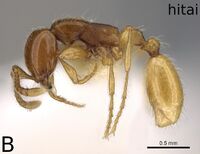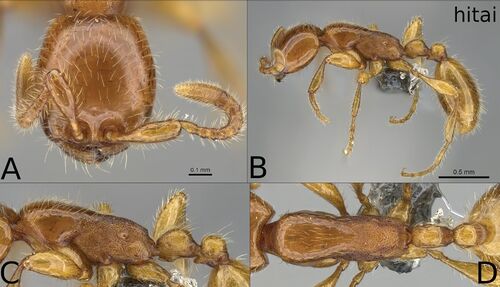Aenictus hitai
| Aenictus hitai | |
|---|---|

| |
| Scientific classification | |
| Kingdom: | Animalia |
| Phylum: | Arthropoda |
| Class: | Insecta |
| Order: | Hymenoptera |
| Family: | Formicidae |
| Subfamily: | Dorylinae |
| Genus: | Aenictus |
| Species group: | rotundatus |
| Species complex: | mariae |
| Species: | A. hitai |
| Binomial name | |
| Aenictus hitai Gomez, 2022 | |
There are few collections of this species. These records show these ants have been found in dry forest and Miombo woodland.
Identification
Gómez (2022) - A member of the mariae species complex in the Aenictus rotundatus species group. This species can be separated from the rest of the mariae complex species due to defined dorsopropodeal sculpturation, similar to that in the mesopleurae and lateropropodeum. It is present even in the minor workers as an alutaceus reticula. The subpetiolar process is also quite specific, with very small (relative to petiolar dome) elliptic bulk and a poorly developed lamella. Some larger individuals may present a larger lamellae, similar to that present in Aenictus mariae, but in these the sculpturation is always clearly reticulated, never smooth as in A. mariae or Aenictus boltoni. Its dense setation is also quite distinct from the other three species in the group.
Keys including this Species
Distribution
Latitudinal Distribution Pattern
Latitudinal Range: 2° to -12°.
| North Temperate |
North Subtropical |
Tropical | South Subtropical |
South Temperate |
- Source: Gomez, 2022
Distribution based on Regional Taxon Lists
Afrotropical Region: Kenya (type locality), Mozambique.
Distribution based on AntMaps
Distribution based on AntWeb specimens
Check data from AntWeb
Countries Occupied
| Number of countries occupied by this species based on AntWiki Regional Taxon Lists. In general, fewer countries occupied indicates a narrower range, while more countries indicates a more widespread species. |

|
Estimated Abundance
| Relative abundance based on number of AntMaps records per species (this species within the purple bar). Fewer records (to the left) indicates a less abundant/encountered species while more records (to the right) indicates more abundant/encountered species. |

|
Biology
Castes
Known from the worker caste. Table of castes known for all Afrotropical Aenictus species.
Worker
Nomenclature
The following information is derived from Barry Bolton's Online Catalogue of the Ants of the World.
- hitai. Aenictus hitai Gómez, 2022: 52, figs. 34A-D, 35A-D, 36 (w.) KENYA, MOZAMBIQUE.
- Type-material: holotype worker, 29 paratype workers.
- Type-locality: holotype Kenya: Kajiado, 20.ix.1978 (J. Darlington); paratypes with same data.
- Type-depository: BMNH.
- Distribution: Kenya, Mozambique.
Unless otherwise noted the text for the remainder of this section is reported from the publication that includes the original description.
Description
Worker
HL: 0.49 [0.37-0.60]; HW: 0.42 [0.28-0.56]; SL: 0.25 [0.17-0.32]; WL: 0.68 [0.50-0.87]; PL: 0.18 [0.13-0.23]; PH: 0.12 [0.09-0.17]; PPL: 0.13 [0.09-0.18]; PPH: 0.10 [0.07-0.15]; CS: 0.46 [0.32-0.58]; CI: 85 [77-93]; SIL: 51 [47-54]; SIW: 60 [54-66]; WL/HW: 161 [150-175]; PI: 148 [135-166]; PPI: 129 [118-149]; CSR: 178; (n=16).
Polymorphic (CSR>170). Head variable from elongate and rectangular in the minor workers (CI~78) to roundly quadrate with convex lateral sides and slightly widest at the middle in the major workers (CI~100). Occipital line straight. Scapes short, just reaching the median line of the head when laid back (SIL~0.52). Funicular segments wider than long, the subapical quadrate, apical about twice longer than wide. Frontal carinae small, not surpassing the torulus and fused between the antennal sockets. Frontal ridges developed distally and projecting over the clypeus in frontal view. Mandibles with a long, sharp apical tooth and 3–7 denticles.
Almost flat in lateral view and subrectangular in dorsal view; mesopropodeal suture very weak with propodeum and metanotum almost forming a continuous line. Transverse mesopleural groove present. Mesometapleural suture present but very weak. Propodeal declivity flat, with posterodorsal and posterolateral ridge from present as a continuous line in major workers but weak, to absent in some minor workers with all intermediate forms present; posterodorsal ridge never projecting as a shelf in lateral view.
Petiole sessile with anterolateral ridges present, anterodorsal and dorsolateral ridges absent. Petiolar dome with a short anterior face sloping at 60º approximately, anterodorsal angle rounded and obtuse, posterodorsal angle right, both rounded, dorsal face horizontal. Postpetiole with anterior and posterior vertical faces, and horizontal dorsal surface, both angles right and rounded. Both domes without carinae or ridges of any kind. Subpetiolar process developed and variable, with a bulky small elliptical process followed by a triangular lamella variable intranidally, usually present only in its anterior slope and directed forward, more or less developed, but always present.
All body surfaces smooth and shining except for meso, metapleurae and propodeum variable from alutaceus smooth in minor workers to strongly reticulated-punctuated in some major workers. Propodeum dorsally with the same sculpturation than laterally. Mandibles from slightly to strongly shagreenate. Overall colour from light yellow to brown. As a general rule, smaller individuals are lighter and smoother than larger ones.
Whole body except propodeal dorsum covered with a short decumbent to reclinated small white setae, very abundant. Dorsum of propodeum bare except for its anterior and posterior borders. The length of the setae smaller than petiole height. Another layer of longer, sparser erect setae present in upper half of head, mesosoma, metasoma and gaster, clearly longer than petiole height. Scapes and funiculus with decumbent to semierect pilosity, shorter than scape width. No pubescence noted.
Type Material
- Holotype worker, KENYA: • Kajiado 20/09/1978 (Darlington, I.) (1w) [NHMUK012849036, top] The Natural History Museum.
- Paratype workers: • same data, (2w) [NHMUK012849036, middle, bottom], (9 pins, 3w each) [NHMUK012849307 to NHMUK012849315] The Natural History Museum.
Etymology
The species name hitai is Latinized noun in the genitive case, dedicated to Dr. Francisco Hita-Garcia, always encouraging and friendly, set aside his vast knowledge of Afrotropical Fauna.


